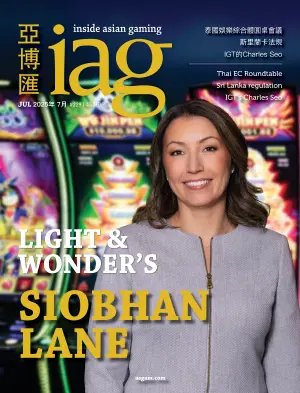Recent developments in the digital marketing space have created new opportunities for companies to target and acquire customers.
While the post-pandemic rebound in Macau has been slow to emerge on the ground, developments in the digital marketing space have accelerated exponentially in the past 18 months, producing an entirely changed landscape for customer acquisition and engagement than the one known in the pre-COVID 19 world. We examine five of the leading innovations in the digital marketing sector and the potential implication for customer engagement.
 BRANDED VIRTUAL WORLDS
BRANDED VIRTUAL WORLDS
While virtual reality has been a fixture on the marketing agenda for quite some time, brands have struggled to exploit the medium for marketing campaigns beyond niche promo-exhibitions or simulated experiences presented via VR headsets, which appealed to few beyond a minority of loyal fanatics. However, the metaverse has become a household name this year, literally given the rebranding of Facebook as Meta, and a growing number of companies are engaging or partnering with metaverse avatar platforms to launch branded digital avatars and brand-inspired digital environments. In these virtual domains, customers can connect virtually with branded products, services and experiences to see, test and purchase online.
The great advantage of the metaverse platform over a dedicated mini-program or app is the ability to funnel existing metaverse users to the brand’s own virtual world for cross-marketing purposes. The metaverse platforms also have the capability to embed branded digital assets for purchase, including digital collectibles and non-fungible tokens that we will discuss further below, to allow for a more holistic brand shopping and engagement experience in a single place – rather than diluted across a diverse array of digital marketplaces, mini-programs and websites. The concept works especially well for destination-type organizations, where a branded-virtual world that reflects the brand’s location can be created in which the customer is immersed and invited to explore simulated activities, thereby cultivating demand and engagement pre-trip for the physical world equivalent.

SOCIAL E-GAMES
Tangential to virtual worlds, the domain of e-games continues to enjoy unparalleled popularity among the under 40s market, forming a main pillar of the digital economy. Unfazed by Chinese government regulations introduced this summer which restricted playing time of under-18s to a maximum of three hours per week – affecting just 7.3% of the gaming population – the e-game market remains dominant and presents an attractive social tool and advertising opportunity for companies to target new customer acquisitions. Placement within the large free-to-play battle royale titles, such as Honor of Kings, PUBG and League of Legends, has proved particularly effective. Branded in-game marketing has taken the form of limited edition branded-skins, weapons, vehicles and other cosmetics designed for particular events which players can collect, trade and purchase for in-game use. Special stages have also emerged as fertile ground for brand collaborations involving entertainment companies for new film or product launches, with themed crossover stages depicting locations and characters released to coincide with film openings. Similarly, battle royale games have presented an emerging platform for a number of in-game music concerts produced by leading artists, with full-scale light and sound shows. During the pandemic, when large scale in-person concert venues were off limits, in-game concerts offered artists and entertainment companies a new, alternative forum to engage new fans with emerging entertainment and music offerings.
Battle royale developers themselves have been expanding their horizons to confer a more social aspect to the games and cultivate broader appeal, beyond classic shooter game audiences. New game modes have included islands devoid of weapons and violence, where the purpose is to grow social relationships by participating in activities alongside fellow players and friends. Social pursuits have included skin diving time trials, boat driving and go-karting, as well as “fun” combat games, such as paint ball shooting, water bombs and burger grenades. Clearly, the proof of concept of these e-games as social entertainment has been achieved, which opens the way for greater use by entertainment and leisure brands that may be reticent to associate with the original weapon-based game version.
We may expect to see further special edition “social” islands in which resort companies collaborate to create digital versions of their facilities as a taster for players to try and experience with friends online before visiting in person. There is also enormous scope for crossovers between in-game purchases and prizes that could be redeemed by players for in-person experiences and events at physical locations.
 DIGITAL COLLECTIBLES
DIGITAL COLLECTIBLES
The undoubted media sensation of 2021 has been the ascendency of digital collectibles, or non-fungible tokens (NFTs), as marketing vehicles for brand engagement. From a technical perspective, these digital tokens comprise of a unique unit of data stored on a digital ledger that certifies the authenticity of the token. Interest in NFTs among collectors soared in the third quarter this year, generating US$10.67 billion in worldwide trading volume, an increase of 704% on the second quarter of 2021. Ant Group, Tencent and JD.com have all launched digital collectible market places for the China market: Alibaba’s digital collectible auction site, Guang Jian, was launched earlier this year to display and sell e-sports, digital copyright, digital arts and digital trading card collectibles. For Mid-Autumn Festival, Alibaba released digital collectible mooncakes that were available for RMB1, built on the Alibaba blockchain platform, AntChain, and sold through its e-commerce platform, Taobao. Ant Group’s Alipay has also issued digital collectibles in honor of the Asian Games 2022, featuring a 3D digital torch for the Games and again supported by the AntChain platform. Rival Tencent also operates a digital collectibles trading platform, Huanhe, which is based on the company’s Zhixin chain.
The route for these digital assets has not been clear-cut in the China market, however, following statements in September this year issued by the People’s Bank of China that reiterated the illegality of virtual currency-related business activities. Ant Group and Tencent subsequently renamed references from NFT to “digital collectibles” on their platforms in order to remove any association with financial speculation and investment. Alipay also introduced the requirement in August for purchasers to hold digital collectibles for a minimum of 180 days before transferring or reselling the digital asset. In a further effort to support compliance, Ant Group, Tencent and JD.com signed a self-regulation convention on digital collectibles/NFTs with Chinese state regulators at the end of October, committing to prevent speculation, financial risk and association with virtual currencies in the digital creative industry.
Beyond the regulatory considerations, brands are exploring digital collectibles as a medium to target new customers through digital giveaways, treasure hunts and promotions. F&B outlets have used NFT giveaways as a promotion mechanism to build in-market awareness among consumers and employees for new product launches. McDonalds China issued a set of NFTs to celebrate its 31st anniversary in the China market, based on the design of the new McDonald’s China HQ offices.
Tourist sites have also been in the front line of digital collectible creation as a means of popularizing their cultural assets and educating the public on cultural history. China’s Hubei Provincial Museum released a series of digital collectibles of the famous Sword of Goujian, a tin bronze sword owned by the Chinese King Goujian of the Yue Kingdom. Launched on the Alipay mini-program, AntChain Fan Points, the digital Goujian sword collectible gave purchasers a detailed view of the artifact to bring the work to life outside of the museum environment.

Overseas, Thailand’s Tourism Authority is also exploring the use of NFTs to boost the tourism market and hasten recovery in the post-pandemic economy. The Thai Tourism Authority has unveiled plans to develop a tourism platform in partnership with the Thai digital currency exchange, Bitkub, to potentially issue a Thai Tourism Coin and NFTs. These digital assets are intended to facilitate virtual currency exchanges to local currency without additional fees while avoiding speculative currency trading activities. The Thai Tourism Coin may lead the way for other tourist countries and destinations to launch similar initiatives within the boundaries of local regulations.
NFT LOYALTY ASSETS
The potential of NFTs extends far beyond the simple release of digital collectibles. NFT ownership has been viewed as a tool to increase customer investment in brands, from an emotional and financial perspective, and for companies to increase long-term customer loyalty.
Brands have started to offer NFTs to VIP customers of their loyalty schemes: the NFTs may comprise of a limited edition, branded digital art piece bundled with the right to receive complimentary brand products or experiences at certain intervals over a long-term period – for instance, once a year for 10 years. These more complex NFTs have evolved from mere digital artworks to embed brand-created rights and benefits in the digital asset, such as access to previews, special edition products and brand experiences, the ownership of which is recorded and verified using the blockchain ledger. By only offering NFTs to VIP loyalty program members, brands can reward membership and incentivize others to join.
 Cultivating membership in loyalty programs has become increasingly important given that access to third party data has become ever-more limited due to data privacy regulation and practices. Encouraging customers to interact more with the loyalty program in the digital environment increases the data the brand has at its disposal to personalize services and offers for an improved customer experience and outcome.
Cultivating membership in loyalty programs has become increasingly important given that access to third party data has become ever-more limited due to data privacy regulation and practices. Encouraging customers to interact more with the loyalty program in the digital environment increases the data the brand has at its disposal to personalize services and offers for an improved customer experience and outcome.
The dynamic between digital and physical versions of the same product, authenticated through the use of NFTs, is also an area of great potential. Brands may choose to restrict sales of a special physical product to customers who already hold the NFT digital version of the same product, or to unlock a special in-person experience only to members who hold the corresponding digital NFT. Brands themselves are working to create virtual stores in metaverse platforms, as mentioned above, where digital merchandise can be bought and worn in the digital environment.
There remain some uncertainties and legal issues to navigate surrounding the scope of rights granted with NFTs: whether NFT “ownership” relates merely to the NFT token and the rights to use the underlying digital asset, or if these extend to ownership of the rights attaching to the digital asset itself. In most cases to date, companies have determined the conditions and rights associated with the NFTs in accordance with the rules of the platform or marketplace on which the NFT is offered. Customers must possess a digital wallet to store the NFTs, but brands are also assisting customers to establish digital wallets as part of the membership experience for those new to the NFT collecting world. These branded NFTs can then serve as a membership or loyalty card for future events and promotions – with authenticity verified on the blockchain. Additional brand benefits for NFT holders can also be continually updated or added at a later stage in order to grant, for instance, special access or use of new brand facilities, restaurants or hotels.
DIGITAL “BLIND” BOXES
A counter-trend to the increasing use of artificial intelligence (AI) and hyper-personalization in product and service offerings is the overwhelming popularity of newly launched “blind” brand boxes. Comprising of a digital and offline component, brands run a digital prize draw, generally through their WeChat mini-program, which customers can enter for a fee. Prizes are issued as digital vouchers to redeem at offline vending machines or in-store, which may include premium and limited edition products, events tickets, travel packages and F&B prizes.
 The success of these “blind” boxes lies in the surprise element of the contents. The element of the unknown is immensely attractive, especially to young consumers, who seek excitement and adventure in the purchasing journey, which has become increasingly difficult in the AI driven world, where most options presented to consumers are already predicted or informed by previous preferences and purchasing behavior.
The success of these “blind” boxes lies in the surprise element of the contents. The element of the unknown is immensely attractive, especially to young consumers, who seek excitement and adventure in the purchasing journey, which has become increasingly difficult in the AI driven world, where most options presented to consumers are already predicted or informed by previous preferences and purchasing behavior.
The “blind” box mechanism therefore satisfies the psychological needs of the customers, and revenue from “blind” box promotions is forecast to grow sizably in the coming years. Companies use the “blind” box channel to giveaway limited edition collection pieces or one-off experience packages, which has fueled the demand among consumers to collect the “blind” boxes and repurchase in order to complete their collection or obtain the prize they want. Rewarding loyal customers with “blind” boxes has also proved a valuable engagement tool and at the same time stimulated further repeat sales of “blind” boxes by these customers on their own account.
The spectacle of discovering the content of the “blind” boxes has proved a social media phenomena in its own right, with customers sharing videos on their own moments channels, thereby generating further exposure and interest from friends and followers. Tmall reports that customers will consider spending large sums on “blind” boxes each year if the content is high value, rare or unique. Brands have found that such digital “blind” box promotions can dramatically increase traffic to WeChat and social media accounts with a greater chance of attracting new and younger customers. Companies in the luxury segment have been especially active in using the digital promotion to generate interest among entry-level and younger customers, and companies from the travel, beauty and fashion sectors have all used digital “blind” box promotions in marketing campaigns.
 Digital advancements have opened the way to a new universe of marketing constructs that support digital to offline crossovers. Companies will need to reconfigure marketing strategies to incorporate the new digital asset forms and metaverse platforms, in order to remain current and meet customers’ expectations for next-generation consumer engagement and experiences.
Digital advancements have opened the way to a new universe of marketing constructs that support digital to offline crossovers. Companies will need to reconfigure marketing strategies to incorporate the new digital asset forms and metaverse platforms, in order to remain current and meet customers’ expectations for next-generation consumer engagement and experiences.

































